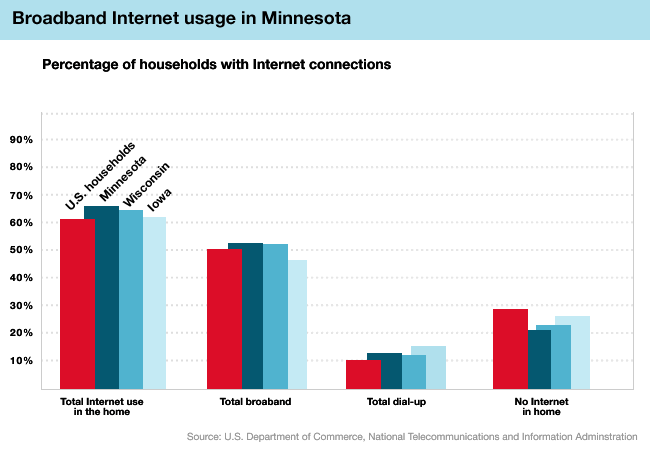New map shows speeds of the information superhighway
Go Deeper.
Create an account or log in to save stories.
Like this?
Thanks for liking this story! We have added it to a list of your favorite stories.

There's a new map of Minnesota being prepared and you're invited to participate. It isn't a roadmap. It's a map of the state's broadband or high-speed Internet service. The new map will show where Internet service is poor or speeds are slow.
This is the state's newest effort to expand access to high speed Internet. Ten years ago a plan fell short when the dot com bubble burst.
Minnesotans can clock the speed of their Internet connection by going to www.connectmn.org. Then click the red button that says, 'I want to test my access speed,' in the right hand corner.

A little dial will appear on the screen telling you the speed of your Internet connection.
Turn Up Your Support
MPR News helps you turn down the noise and build shared understanding. Turn up your support for this public resource and keep trusted journalism accessible to all.
Minnesota Commerce Department spokeswoman Diane Wells said the speed number will let consumers and the state map makers know if the company supplying home Internet service is truthful.
"They're using that information to cross reference it to what the providers are reporting to ensure that the providers are reporting accurately," Wells said.
According to Wells, Minnesota's broadband map is being created now and will be released in a week or two.
Broadband, its advocates argue, is infrastructure, no different from roads and bridges and vital to economic development.
An earlier attempt to expand high speed Internet service in Minnesota is buried along Interstate 94 between Moorhead and St. Cloud.
Minnesota created a partnership with a company to lay 2,000 miles of fiber optic cable along the state's major roadways.
The idea was to build a broadband skeleton that would link the state with high-speed Internet access.
The plan went kaput when the bubble of investment in Internet technology companies burst in 2001, and the state's partner went bust.
There are 48 strands of fiber optic cable buried along the corridor and fewer than half of them are being used.
Broadband advocates worry this underutilized fiber is an example of how Minnesota has slipped to a mid-rank status when it comes to broadband access.
They are heartened by the creation of a state broadband task force that will prepare recommendations for expanding service.
The big cable and telephone companies who supply most of the country's high-speed Internet service say they build broadband infrastructure in a community if there are enough customers.
Former state lawmaker Steve Kelley favors a 'build it and they will come' approach to expanding broadband.
Kelley directs the Center for Science Technology and Public Policy at the University of Minnesota's Humphrey Institute.
He said once people see the opportunities high-speed Internet service creates, if its available, they'll buy it.
"When the tools are there ahead of time people invent lots of new ways to use it," Kelley said. "So I do think we've fallen behind on providing the capacity and infrastructure that will generate new innovation in how we use it."
The question Kelley's "build it and they will come" model raises is where to find the money. Building broadband infrastructure isn't cheap.
The 250 miles of fiber optic cable along Interstate 94, ten years ago, cost $30 million.
Broadband advocates say look to the past for funding ideas.
Seventy years ago, during the Great Depression and as part of the New Deal, government subsidies underwrote the cost of bringing electricity to rural areas.
Also, telephone customers, then and now, pay a universal service fee to help pay for telephone service to under-served areas.
That's the model Steve Kelley and others recommend for making broadband high-speed Internet service available to more Minnesotans.
In fact, telephone cooperatives that trace their roots to the New Deal era have already jumped into the broadband market.
Bernadine Joselyn, who directs the Grand Rapids-based Blandin Foundation's Broadband Initiative, said Minnesota's local phone cooperatives supply some of fastest speeds at the lowest prices.
"We, in fact, are leading the nation in terms of laying fiber in rural areas thanks to the vision and commitment of many of those local telephone cooperatives," Joselyn said.
Still, monthly high-speed Internet service is too expensive for low income Minnesotans.
So, one argument is set a goal, perhaps $20 a month for affordable broadband access.
Fine, said John Stanoch, the president of Qwest in Minnesota, the state's largest telephone company and a major broadband supplier.
Just understand, Stanoch said, the money for supplying the service and subsidizing the rates has to come from somewhere.
"Somebody is going to pay, if the $20 per month does not reflect the cost of putting the network in the ground, does not reflect the cost of operating and maintaining and upgrading that network, somebody is going to be subsidizing that," Stanoch said.
The Obama administration and Congress have put forward separate plans to expand broadband service as part of a stimulus package.
Minnesota officials said they'll have the state's map of broadband access ready in time to present to the Minnesota Congressional delegation and show them projects that are ready to be built when and if the stimulus money starts flowing.





